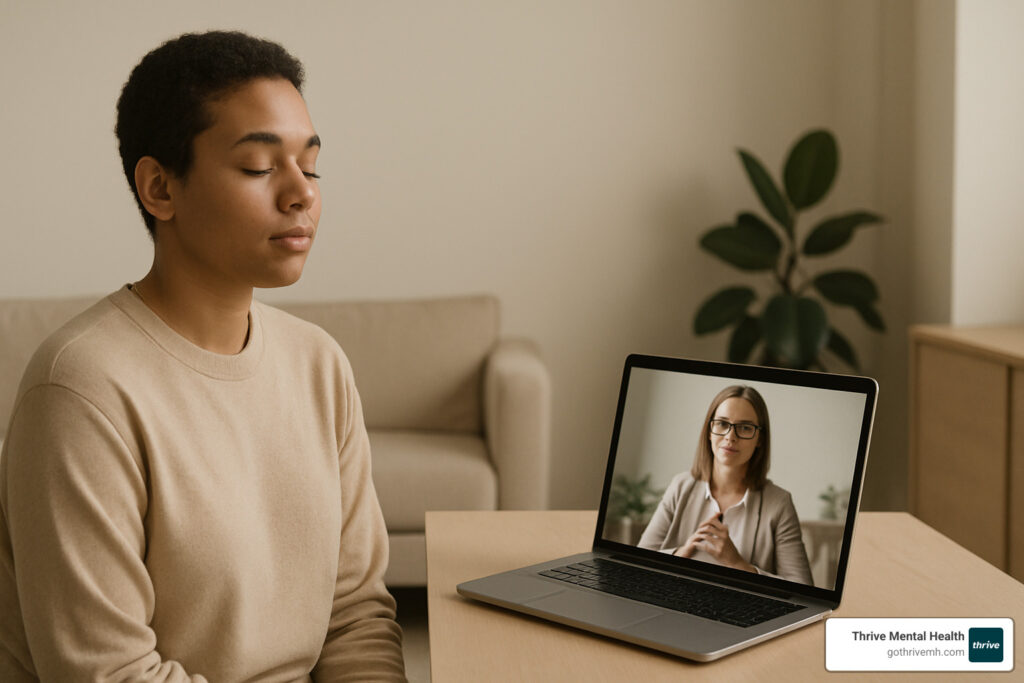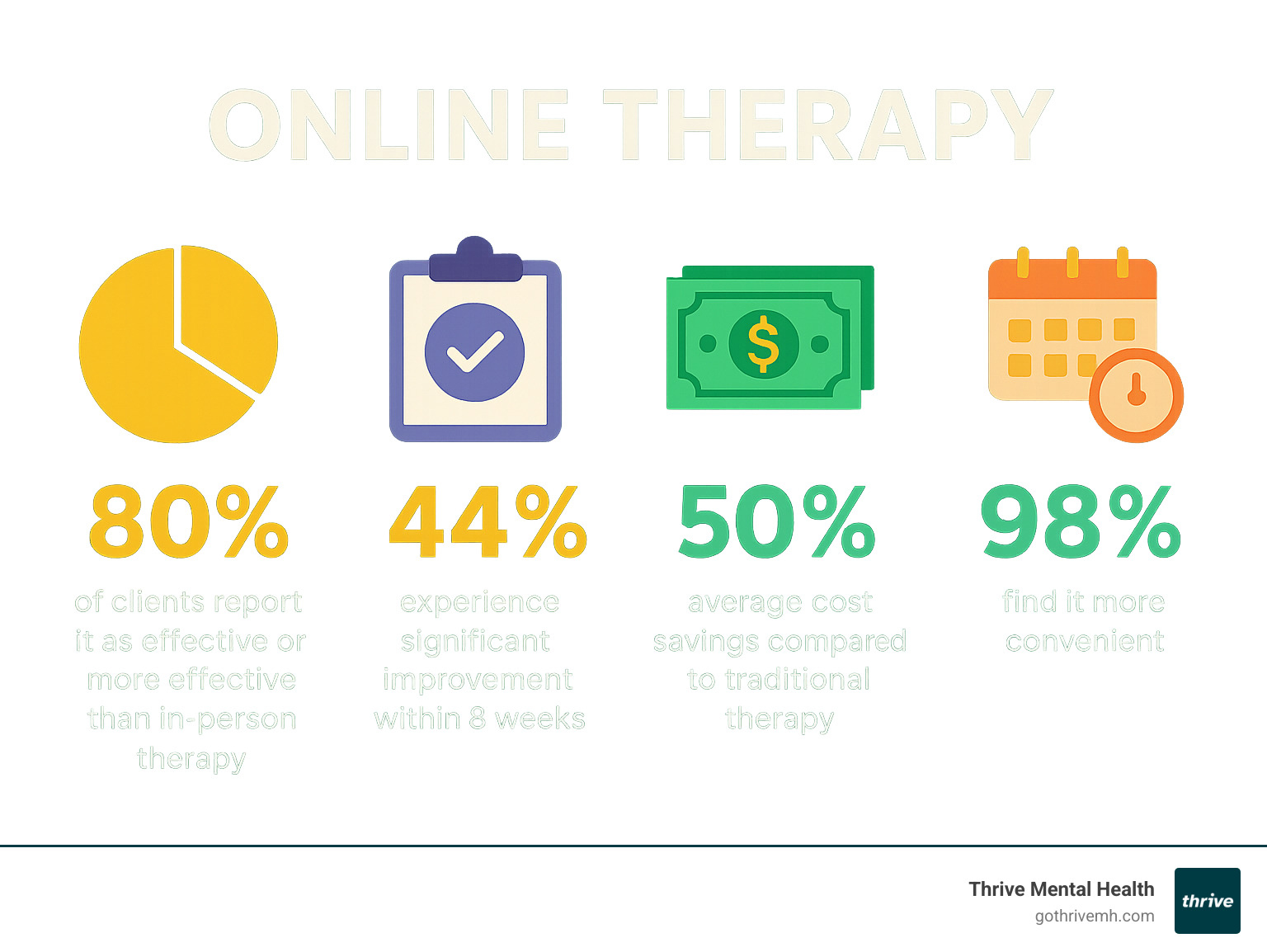In Depth Guide to Finding the Best Online Therapy Options

Why Online Therapy is Revolutionizing Mental Health Care
Online therapy lets you meet with a licensed mental-health professional through secure video, phone, or messaging—no commute, no waiting room, no schedule gymnastics. Decades of research now show that, for most stress, anxiety, and mood issues, virtual care works just as well as sitting in an office.
Quick facts you should know:
- What it is: HIPAA-secure counseling delivered digitally
- Typical cost: $65–$100 a week vs. $125–$300 per in-person session
- Insurance: Most major U.S. plans now reimburse telehealth
- Effectiveness: Studies find equal or better outcomes for depression and anxiety
- Privacy: Platforms use medical-grade encryption and follow the same laws as brick-and-mortar clinics
More than 4 million people have used online therapy platforms since 2013. Busy professionals, parents, students, and rural residents have finded that seeing a therapist from a laptop, tablet, or phone removes the last barriers to consistent mental-health care.
“I’m a truck driver and can get therapy from the road—it’s wonderful,” one Thrive client told us. Comments like that illustrate why digital care has stuck even after offices reopened.
I’m Nate Raine, CEO of Thrive Mental Health. After a decade building virtual intensive outpatient programs (IOPs) and partial hospitalization programs (PHPs), I’ve seen online therapy transform lives that traditional services simply couldn’t reach.

Find out more:
Understanding What Online Therapy Is and How It Works
Online therapy is traditional counseling delivered through modern tools. Log in, meet your therapist, and start talking—exactly as you would in an office, minus the drive.
Common formats
- Video sessions (most like face-to-face)
- Live chat (good when privacy is limited)
- Asynchronous messaging (write when thoughts pop up; therapist replies within a day)
- Phone calls (ideal for low-bandwidth or camera-shy clients)
Most clients switch among these methods as life demands.
What Can Be Treated?

Research shows virtual care is comparable to in-person treatment for:
- Anxiety and panic disorders
- Depression and mood swings
- Work or relationship stress
- Grief and life transitions
- Trauma and PTSD (with EMDR or trauma-focused CBT)
- Substance-use relapse prevention
See Online Cognitive Therapy for details on evidence-based protocols.
Online vs. In-Person: A Quick Comparison
| Factor | Online | In-Person |
|---|---|---|
| Cost | $65–$100/wk | $125–$300/session |
| Scheduling | Early, late, or weekend | Office hours only |
| Commute | None | 15–60 min each way |
| Therapist Pool | Nationwide | Local only |
| Privacy | Home environment | Possible waiting-room encounters |
| Crisis Response | Limited to referrals | Immediate in office |
For most mild-to-moderate concerns, the flexibility of online therapy outweighs the few drawbacks. If you require intensive in-person monitoring, a hybrid plan or higher level of care may be recommended.
Learn more at Virtual Therapy: A Convenient and Effective Approach to Counseling.
The Effectiveness and Key Benefits of Choosing Online Therapy
Decades of peer-reviewed studies confirm that online therapy works—often matching or out-performing office-based care for anxiety, depression, and stress.
Key findings
- A landmark review in JAMA Psychiatry found online CBT reduced depressive symptoms as effectively as face-to-face CBT.
- Clients save roughly 50 % when factoring in travel and time off work.
- 80 % of users report equal or better satisfaction compared with prior in-office experiences.
Why outcomes are strong
- Accessibility—people attend more sessions when there’s no commute.
- Real-world practice—skills are learned in the same environment that triggers symptoms.
- Messaging—quick check-ins keep therapy on track between appointments.
Main Advantages at a Glance
- No travel, parking, or childcare hassles
- Comfort of home improves openness
- Available to rural or mobility-limited clients
- Evening/weekend slots fit demanding jobs
- Wider choice of specialists (e.g., LGBTQIA+-affirming, EMDR-certified)
- Lower stigma—nobody sees you enter an office
For people needing more structure than weekly sessions, Thrive’s Virtual Intensive Outpatient Program (VIOP) layers group work, skills classes, and psychiatry onto individual therapy—all online.
How to Choose the Right Online Therapist for Your Needs

A strong therapeutic match predicts better outcomes than any single technique. Use these steps to vet providers:
- Confirm credentials: PhD/PsyD, LCSW, LMFT, or LPC—and licensed in the state where you’ll be during sessions.
- Review specialties: trauma, couples, OCD, etc. Pick someone experienced with your top concern.
- Ask for a brief consult call (many offer 10–15 min free) to sample their style.
- Evaluate fit: Do you feel heard? Do goals and approach make sense?
Questions to ask
- How much experience do you have treating my issue?
- Which evidence-based methods do you use?
- What is your availability for sessions and between-session messages?
- How will we measure progress?
Detailed guidance: How to Choose the Right Individual Online Counseling Service for Your Needs.
Need a niche expert? Browse directories for EMDR therapists, DBT programs, or How Online DBT is Revolutionizing Mental Health Care.
Navigating Cost, Insurance, and Privacy in Online Therapy
Online therapy is usually easier on the wallet—and your data are protected by the same laws that govern hospitals.
Cost basics
- Subscription platforms: $260–$400/month for weekly live sessions plus unlimited messaging
- Per-session pricing: $65–$100
- Sliding scales: Many private clinicians discount based on income
- FSA/HSA cards: Often accepted for tax-free payment
Insurance Coverage
The Mental Health Parity and Addiction Equity Act requires most U.S. plans to cover telehealth at the same rate as in-person care. Still, confirm specifics:
- Is online therapy covered under my plan?
- What will my copay or coinsurance be?
- Do I need to use an in-network platform?
- Is pre-authorization required?
Some services bill insurance directly; others provide a superbill for reimbursement.
Privacy & Security
- All reputable platforms are HIPAA-compliant.
- Video, audio, and messages are encrypted end-to-end (often 256-bit SSL).
- Therapists follow the same confidentiality rules they would in an office.
Protect your own privacy by using a secure internet connection, logging out after sessions, and choosing a quiet room.
For further details, visit Mental Health Care Online.
What to Expect: Sessions, Duration, and Limitations
Starting online therapy is straightforward. Your first meeting includes a quick tech check, a discussion of goals, and a plan for frequency—usually weekly at first.
Typical flow (45–50 min):
- 5 min: Check-in & last-week recap
- 25 min: Core therapeutic work (e.g., CBT exercises)
- 10 min: Skill practice & feedback
- 5 min: Wrap-up and homework
Most clients notice improvement within 8–12 sessions for anxiety or mild depression; complex trauma or dual diagnoses can require longer care. Messaging between appointments keeps momentum going.
Limitations to Know
- Emergencies: Online therapists cannot offer in-person crisis intervention. Call 988 in the U.S. if you’re in immediate danger.
- Severe mental illness: Active psychosis, uncontrolled mania, or medical detox needs higher-level, face-to-face care.
- Medication: Only psychiatrists or psychiatric NPs can prescribe.
- Licensing: You must be located in a state where your therapist holds a license at the time of each session.
For structured, higher-intensity care without leaving home, see Navigating Your Recovery Journey: An Inside Look at Virtual CBT and IOP.
Frequently Asked Questions about Virtual Mental Health Care
Can an online therapist prescribe medication?
Usually no—psychologists, counselors, and social workers don’t have prescribing authority. Many platforms partner with tele-psychiatrists who can handle medication if needed.
Is online therapy private and secure?
Yes. HIPAA-compliant software encrypts data in transit and at rest. You can add extra safety by using headphones and a private room.
Can I see a therapist in another state or country?
Not unless they also hold a license where you are physically located during the session. Licensing boards enforce this to protect client safety.

Conclusion
Online therapy has moved from a novelty to a mainstream option backed by solid science and used by millions. It offers:
- Proven effectiveness—80 % of users rate it equal or superior to office visits
- Genuine convenience—sessions from home, work, or on the road
- Cost and time savings that remove the last barriers to care
Thrive Mental Health pairs this convenience with evidence-based IOP and PHP programs for adults and young professionals who need more than once-a-week support. Our licensed clinicians tailor CBT, DBT, and trauma-informed therapies to your goals—wherever you log in.
If stress, anxiety, or life changes are holding you back, consider giving virtual care a try. Explore how virtual therapy can provide a convenient and effective path to wellness and take your first step toward thriving today.